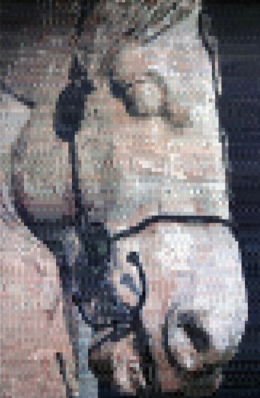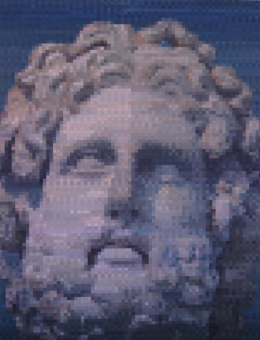By Nadine Moedt (The Cascade) – Email
Print Edition: October 24, 2012
Visual Arts instructor Christopher Friesen’s work is currently being showcased at the Elissa Cristall Gallery in Vancouver. The showing, entitled Digital Artifacts, represents a “dialogue between past and present,” connecting the pixilations we see in technology today with various artifacts of the past. In this interview with The Cascade Friesen comments on his work, talks about inspiration, discusses his creative process and gives a word of advice to aspiring artists.

Yeah, absolutely. The work that’s there is commenting on the technology as well as the artifacts, so trying to produce work of a contemporary nature. It’s work that is relevant to how we view the world today, but . . . [we can] compare it to historical moments of production. For instance, the piece called “Monumento,” is kind of a title that is of an artifact but also potentially a souvenir. So taking that image when I was in the British Museum, and there researching another exhibition, just through that process I discovered that there was kind interesting things going on about just being in that space, about people interacting with the artifacts. For instance, the British Museum houses the Rosetta Stone. I was absolutely amazed at how people were treating it – just like a celebrity. They were surrounding it, taking pictures of it, pushing other people out of the way to take pictures of it . . . walking through, looking at the sculptures, giving their own running commentary of the sculptures . . . They’re not interested in the didactic information about what the actual object is, they’re imposing their own narrative on it. So that’s where the crux of the exhibition comes about; just trying to find how are we looking at technology but also looking at what’s going on in today’s world that we just sort of discard, in the sense of where the digital artifact comes from. Because the artifacts in the British Museum are just sort of broken, they’re pulled out of the earth, out of garbage dumps essentially, and we get to take them, re-inscribe them with value, talk about them in a significant way supposedly, yet there is a running dialogue about how they relate to the contemporary world.
What influences your art? Where do you find inspiration?
Technology. I think artists have to deal with what it means to be contemporary. How are you going to say something new with your material that’s relevant for an audience? So looking at technology and looking at how specifically digital technology affects the way that we see things, which is why these pictures are broken down and pixilated. It makes reference to technology but also because they’re paint, [we] are able to comment on it because it’s not digital imagery working with digital imagery, it’s digital imagery working with someone interpreting that . . . The influence is how we interact with images today. I look at technology as one of those filters through which we see the world.

I think it comes out of just observing. I’m a painter. Things kind of need to fall into that language. But it kind of starts to resolve itself when you’re out in the world. I was there shooting images for a previous show, but having this moment where, “I can’t use this idea now, it’s not fully formed,” but I’m just really intrigued by the phenomenon, how people engage in a space, where it’s supposedly about learning, but there’s just so many other things going on, you know, people looking at, for instance, this image I have of a portrait of a roman bust, but I’m calling it “Morrison,” because when people walk past, they’re like “wow that looks like Jim Morrison,” it’s 2000 years earlier. I find that interesting . . . People trying to make sense given their own frame of reference. You know, something that exists in the past and in the present, so it becomes pop culture as much as it is referencing a western mode of artistic production . . . referencing these little moments of technology. You’ve probably seen online where you watch a video and there’s a compressioner and then it freezes and has these little pixilations, then it kind of continues. Those little pixilations are called digital artifacts. Digital artifacts by definition are not intended, they’re an accident, they’re considered garbage, no one really wants these, but it has everything to do with how our technology is in this idea of progress. For me online too I look at student pictures that are pixilated and have these little artifacts.
It’s a matter of noticing them and then finding out what exactly they are and how they can be used to talk about what it means to be in the visual arts field today. It’s interesting because I call it looking for a moth – it has everything to do with what James Alkin talked about in his book The Object Stares Back, which is, once you learn how to see something, you see it. And he talks about a moth on a tree, and how that moth could be there all day, with people walking past it. But the second you look for that little outline around the wing, you start seeing them everywhere. And that’s what the digital artifact has become to me, it’s my moth. I can see it everywhere.
Do you have any advice for aspiring artists?
Literally, it comes to work ethic. You need to be in the studio, you need to be doing it; otherwise, you deny the possibility of anything happening. If you think about becoming an artist, it’s a process of becoming, but it’s also a process of just doing it, and working and working and finding out what you find interesting about the material. Because no one can tell you what’s interesting about it. You’re going to have that moment where this becomes absolutely, crucially important in your life and your way to kind of communicate with the world, or for you to understand the world. So really, the only advice is to get out and see work, get out there and create work. And slowly you’ll come to a realization of what it means for you.
Friesen is “taking a step back” on any current projects; he and his wife just had a baby, so he’s a bit preoccupied. Friesen’s show runs until October 27. To see his work online, visit the Elissa Cristall Gallery website.


